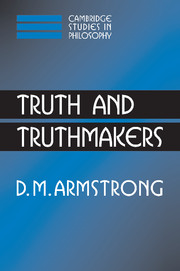Book contents
- Frontmatter
- Contents
- Preface
- 1 An introduction to truthmakers
- 2 The general theory of truthmaking
- 3 Epistemology and methodology
- 4 Properties, relations and states of affairs
- 5 Negative truths
- 6 General truths
- 7 Truthmakers for modal truths, part 1: possibility
- 8 Truthmakers for modal truths, part 2: necessity
- 9 Numbers and classes
- 10 Causes, laws and dispositions
- 11 Time
- References
- Index
10 - Causes, laws and dispositions
Published online by Cambridge University Press: 22 September 2009
- Frontmatter
- Contents
- Preface
- 1 An introduction to truthmakers
- 2 The general theory of truthmaking
- 3 Epistemology and methodology
- 4 Properties, relations and states of affairs
- 5 Negative truths
- 6 General truths
- 7 Truthmakers for modal truths, part 1: possibility
- 8 Truthmakers for modal truths, part 2: necessity
- 9 Numbers and classes
- 10 Causes, laws and dispositions
- 11 Time
- References
- Index
Summary
TRUTHMAKERS FOR CAUSAL TRUTHS
We know that, in innumerable cases, one billiard ball strikes another and causes the latter to move. David Hume, very justly, used this as a paradigm case of causation: one token event causing a further individual event to occur. But given that it is true that a token event C causes a further event E to occur, what is the truthmaker for this truth? What metaphysics of causation should we accept?
According to the ‘Humean’ tradition (I use quotation marks here to distance myself from the scholarly question of what Hume himself actually believed), what makes the individual sequence a causal sequence lies outside that sequence. Considered in abstraction from its spatiotemporal environment, the sequence is neither causal nor not causal. It is in virtue of the right spatiotemporal context that such a sequence is causal. The notion of a cause is tied to that of some regularity in nature. Along with the regularity theory of causation goes a regularity theory of laws. A residual problem remains: not all laws of nature seem to be causal laws. (Conservation laws are not implausible candidates.) What marks off causal laws from laws that are not causal? Humeans, however, hardly bother to distinguish them.
It may be added that the counterfactual theory of causality popularized by David Lewis is fundamentally a Humean theory, at any rate as Lewis developed it.
- Type
- Chapter
- Information
- Truth and Truthmakers , pp. 125 - 144Publisher: Cambridge University PressPrint publication year: 2004



